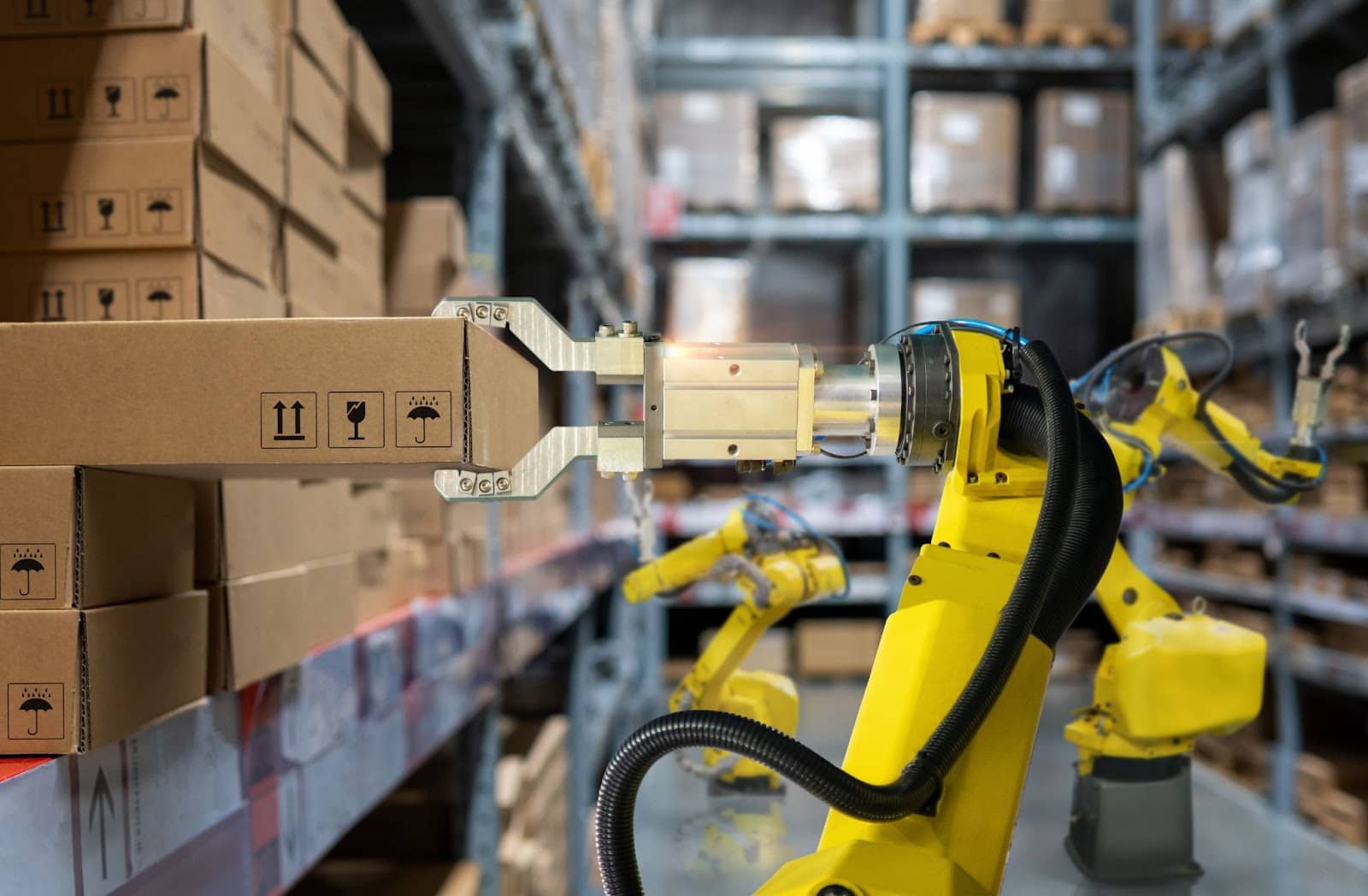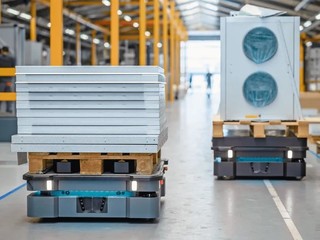Companies like Amazon, Walmart, Alibaba, and UPS have been making investments for years

As we're previously written about, automation is becoming a bigger and bigger factor in the manufacturing industry, with technologies like automated guided vehicles (AVG), automated autonomous mobile robots (AMR), artificial intelligence, and robotic arms, all working together to help make workers more efficient, and safer, while allowing them to focus on more important tasks than moving boxes around and scanning them.
There's still a very long way to go, though, when it comes to full implementation: more than 80% of warehouses lacked any form of automation as of 2021. Yet, this is also a fast growing space, with the global warehouse automation market valued at over $23 billion in 2023, with the expectation of a compound annual growth rate of about 15%, bringing the market size to $41 billion in 2027.
That means there's a lot of opportunity for growth and right now it's the large corporations leading the way, particularly Amazon, which has been investing in this technology since it acquired Kiva Systems, a maker of robots to service warehouses, in 2012. However, it wasn't until 2022 that it unveiled Proteus, its first fully autonomous mobile robot, which autonomously moves through Amazon facilities using advanced safety, perception, and navigation technology developed by Amazon. The robot works like an AMR rather than an AVG; AMRs work like cars, where they can drive and maneuver around obstacles on their own, while AGVs are more like trains where they're on a set path and can't keep going if something is blocking them.
"It can operate in a manner that augments simple, safe interaction between technology and people—opening up a broader range of possible uses to help our employees—such as the lifting and movement of GoCarts, the non-automated, wheeled transports used to move packages through our facilities," Amazon wrote at the time.
Proteus was initially deployed in the outbound GoCart handling areas in Amazon' fulfillment centers and sort centers.
At the same time, Amazon also debuted Cardinal, a robotic workcell that uses AI and computer vision to select packages out of a pile of packages, lift it, read the label, and place it in a GoCart, as well as Amazon Robotics Identification (AR ID), an AI-powered scanning capability with computer vision and machine learning technology to remove the process of manually packages, instead using a camera system that runs at 120 frames per second to scan the package automatically.
More recently, Amazon also launched a new robotic system called Sequoia at one of its fulfillment centers in Houston, Texas which allows it to identify and store inventory up to 75% faster. When orders are placed, Sequoia also reduces the time it takes to process an order through a fulfillment center by up to 25%.
Alibaba robot initiatives
Another major player in the warehouse automation space is Amazon's Chinese equivalent, Alibaba, which owns a majority of logistics arm Cainiao Network, a company that operates numerous automated fulfillment centers equipped with robotics and AGVs. In 2018, Cainiao opened China’s biggest robot warehouse, with over 700 robots working in it to deal with the demand from Singles Day, the huge annual shopping festival run by Alibaba.
In 2022, it announced its first overseas partnership with Flash Express, a Thai eCommerce logistics company. The 20,000 square meters host facility is the largest smart warehouse in the region with 100 AGVs used within an area of 5,000 square meters. That same year, Alibaba Group said it planned to deploy 1,000 robots, developed by Cainiao and its research arm, DAMO Academy, across Chinese university campuses and local communities over the following year.
JD.com's robot initiatives
Another major player in China's e-commerce sector is JD.com, which operates a network of automated fulfillment centers equipped with robotic arms, conveyor belts, and sorting systems powered by AI.
In 2014, the company announced the launch of operations for the initial phase of its first highly automated "Asia No.1" 100,000 square meters warehouse, located in Shanghai and in 2018 JD.com opened a warehouse that could handle 200,000 orders a day while employing only four people whose jobs centered around servicing the robots who actually do the work.
In 2022, the company partnered with Tyson China on a jointly-established automated cold chain warehouse in Rizhao, Shandong province which included a 17.8-meter high AS/RS (automated storage and retrieval system), with double extensor stacker, pallet-type conveyor, AGVs, four-way shuttles, and an RFID information labeling system.
The next year, JD Logistics United States, the North American logistics arm of JD.com, announced that it opened its third “self-operating” warehouse and distribution center in California, which uses a container transport unit (CTU) system in which trucks deliver goods to the warehouse, where they are offloaded onto a network of automated conveyors and scanned, sorted, and stored by autonomous robots. Image scanners check the packages, while a smart logistics system calculates where the packages should be dropped off.
Walmart robot initiatives
Back in the US, Walmart has been ramping up its automation efforts in recent years as well, as a response to the rising competition from online retailers like Amazon. It's leveraging robotics and machine learning algorithms to optimize inventory management, reduce operating costs, and enhance the overall efficiency of its supply chain.
The company began working with robotics company Symbotic in 2017 to optimize its supply chain, testing it in its Brooksville, Florida, distribution center. The technology system works to sort, store, retrieve and pack freight onto pallets, and Walmart began using it to optimize intake, increase accuracy, and change how freight is handled at its regional distribution centers (RDCs). In 2021, it announced that it would be implementing the Symbotic automation system in 25 of its 42 RDCs, before expanding it to all of them the following year.
In 2019, the company announced it was building a 340,000-square-foot high-tech consolidation center, which would be the first in Walmart’s supply chain to receive, sort and ship freight.
"This automated technology will enable three times more volume to flow throughout the center and helps Walmart deliver the right product to the right store, so customers can find the products they need," the company wrote.
UPS robot initiatives
Another company deploying automation in its warehouses is UPS, which has been investing in technologies to improve the speed and accuracy of order processing, particularly in its massive distribution centers. It uses automated sorting systems, robotic arms, and advanced tracking algorithms to handle millions of packages every day.
Starting in 2020, the company has implemented an automated storage and retrieval system (ASRS) in its UPS Global Logistics & Distribution in Europe. A similar system was also implemented for another UPS customer at a distribution facility in Butzbach, Germany.
"Automated storage and retrieval systems are revolutionizing traditional warehousing and order fulfillment. Sprawling buildings filled with tall racks, wide rows and loud forklifts are being replaced by grids and bins with robotic arms and workstations," wrote UPS.
In 2022, UPS deployed a fleet of Locus Robotics (AMRs, also known as LocusBots, to help automate the picking workflow in the warehouse. As a result, productivity increased from 40-45 lines per hour (LPH) to 80-90 LPH with the LocusBots. Some workers achieved close to 100 LPH in some cases, better than the initial target of an average of 74 LPH.
In 2023, UPS opened its Velocity facility in Louisville, Kentucky, with over 700 bots in operation to process over 350,000 items per day. The company also unveiled UPS Supply Chain Symphony, a unified data platform to give its customers a direct connection to the supply chain with real-time data and insights.
(This story is part of a series looking at innovation and automation inside warehouses. Among the stories we've covered are Solving the manufacturing labor shortage through automation, including companies such as Noovelia, Amazon Robotics, GreyOrange, and MuL Technologies that are developing robots to make warehouses and manufacturing facilities more efficient)
(Image source: inboundlogistics.com)


